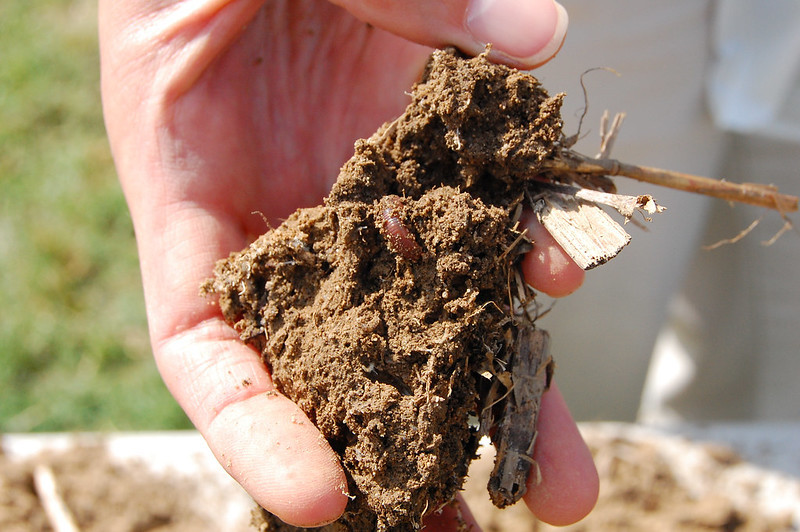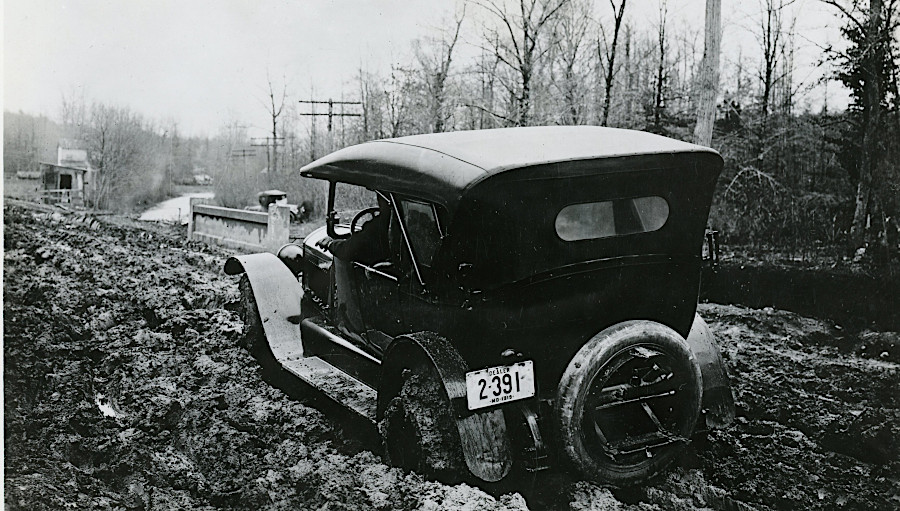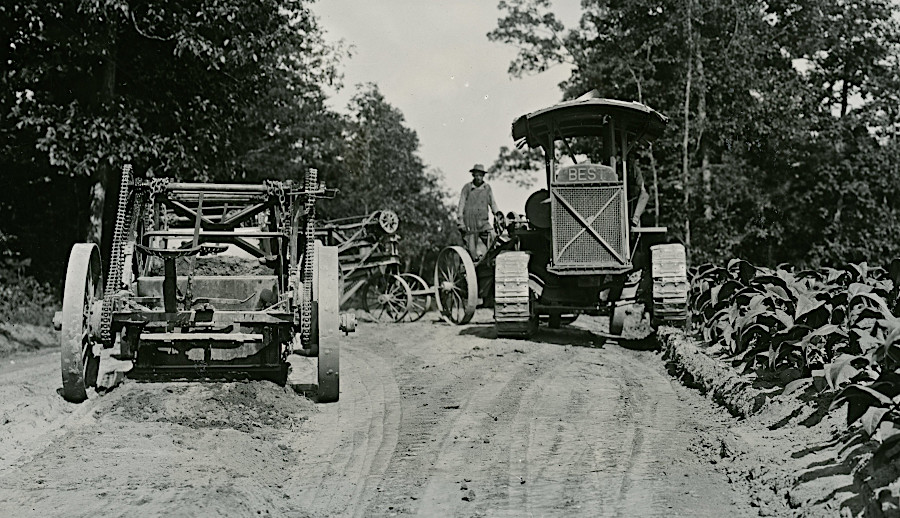
healthy farm soil has a high percentage of carbon and a structure that allows for water to flow around roots
Source: Chesapeake Bay Program, Midway Farms in Richmond County, Virginia

healthy farm soil has a high percentage of carbon and a structure that allows for water to flow around roots
Source: Chesapeake Bay Program, Midway Farms in Richmond County, Virginia
"Dirt" is weathered bedrock. Erosion removes the surface and brings buried bedrock closer to exposure to air and groundwater. Minerals in bedrock can change as they are exposed to less heat and pressure. Atoms realign and form different mineral crystals, especially as bedrock is exposed to water. Gaps between crystals form as the shapes of new molecules align differently, creating wider spaces for water and air to migrate underground.
"Soil" develops over time from bedrock as it is modified by biogeochemical processes. Pedogenesis typically adds organic material, and alters the texture and structure of the original mineral particles. Soil is the top part of the earth's crust.
A soil scientist at Virginia Tech won the individual competition in an international soil judging contest at the 2022 World Congress of Soil Science. In an interview with the Science Friday host, Clare Tallamy described the difference between soil and dirt:1

marl and oyster beds rich in lime were key to soil fertility projects in the mid-1800's
Source: Northeastern University, Travels into North America (by Peter Kalm, 1770, p.97)
Fresh and salt water, ice, carbon from decaying plants and animals, various chemicals from organic material, roots, earthworms, and other living creatures gradually affect the bedrock and transform it into soil near the surface. There are different horizons of soil, with those at the surface having a higher percentage of carbon from biological activity.
The organic component in forest soils comes from leaf litter decaying into humus at the surface, forming an O horizon at the surface of the ground. The organic component in grassland soils comes primarily from roots, increasing the percentage of carbon at depth rather than just on the surface. Just beneath the O horizon is the A horizon, which in Virginia will have roughly 2-4% organic material if undisturbed. Beneath the A horizon is the B horizon. In that subsoil, 50% or less of the particles are decomposing bedrock or parent material but organic material is scarce. Below the B horizon is the C horizon, where the bedrock is just beginning to fragment into particles.
Residential construction projects typically start by scraping off the organic-rich topsoil and stockpiling it. The relatively sterile subsoil is exposed and pushed around the site during construction to provide mechanical support where needed. When a building is completed, the topsoil is spread back onto the surface and planted with grass seed. The topsoil is essential to establish a future lawn; it is more fertile than the subsoil excavated from greater depth.
Physical disaggregation of molecules and chemical decomposition slowly weather the original minerals into different forms that determine the structure and water-holding capacity of a soil. Bedrock with silica-rich minerals, such as quartz and feldspars, carbonates, and iron oxides can decompose into clays with particles flattened against each other like shingles on a roof, or plates in a kitchen cabinet. That alignment blocks the flow of water. Clay is used to line the bottom of farm ponds, ensuring a watertight seal so the water in the pond does not seep into the ground.
Different types of soils evolve under different conditions and from different source minerals. Soil scientists classify soils by different characteristics using a taxonomy of terms such as "hapludult" and "podzol" that is comparable to the way botanists classify plants and astronomers classify galaxies.
Geotechnical engineers measure the ability of soil to support heavy structures and traffic on roads. Artists creating pottery care about the percentage of clay vs. other impurities in a soil. Farmers care about the ability of soils to grow crops, including the amount of organic material that can provide nutrients and store rainwater:2

prime farmland in Virginia
Source: Virginia's Land and Energy Navigator (VALEN)
The transformation of dirt into soil, the chemical and physical alteration of bedrock, is facilitated by plant roots. Roots grow to different depths, so the thickness of soil requires making a judgment call. By definition, the depth of soil does not exceed 79 inches:3
Soil rich in organic material can have gaps between particles that store rainfall. Raindrops that seep into the ground fill those gaps. If rainfall is steady, the soil near the surface will become saturated and water will fill gaps between soil particles located deep underground. After the sun emerges again, surface soil particles will be depleted of water through direct evaporation and through evapotranspiration as roots suck water up into plants.
At depth, the gaps remain always saturated with water. The "water table" is a line at depth which makes the boundary between saturated and unsaturated gaps between particles. Below the water table is the phreatic zone; above the water table is the vadose zone.
Plants rely upon groundwater located near the surface in the vadose zone. Almost all roots in Virginia grow in the top two feet of soil. Outside of wetland areas and riparian zones, plants do not grow roots deep enough to reach the water table. The water table is often 10-30 feet deep, far below the level of plant roots. If there is no rain for 10 days during the hot days in July/August, then roots can not access water. At such times plants experience drought stress and leaves curl to conserve water. Continued drought can kill plants.
A 1% increase in organic matter in soil can great the spaces needed to store an extra inch of rainwater. Crops on agricultural fields consume a quarter of an inch of water daily during the growing season. Farmers who increase the organic percentage in their soil can gain extra productivity and profits, as plants in organic-rich soils can continue to grow steadily during long gaps between rainstorms.4
Source: Virginia Extension, Common soil types in different regions of Virginia (January 12, 2015)
The earliest settlers who arrived about 20,000 years ago recognized that soils in bottomlands near rivers had a higher percentage of carbon and were more productive. Planting corn and other crops on hillsides produced less food. Water from storms steadily constantly washes soil particles downhill thanks to gravity. Those soil particles, enriched with carbon from plant roots and decomposing leaf litter, have accumulated on floodplains ever since the Appalachians were uplifted 300 million years ago. Erosion has created and removed floodplains over and over again since the breakup of Pangea.
The quality of soil has shaped the pattern of human settlement. After adopting agriculture about 3,000 years ago, Native Americans built towns next to where they farmed - and they farmed where the soil was most productive, on floodplains. The beans grown together with squash and corn "fixed" nitrogen in the soil, but the first Virginia farmers did not fertilize. Unlike the Wampanoag in Massachusetts, the tribes on Virginia's Coastal Plain did not catch herring and put the fish next to the corn stalks in order to provide nutrients.
Crops decline in productivity after a few years of farming the same fields because key nutrients (particularly nitrogen, phosphorous, and potassium) would be removed from the soil and concentrated in plants, or washed away. When plant material such as ears of corn was removed from the field, then the nutrients were lost.
To maintain production, Native America farmers cleared new farm fields next to the old ones. When the new fields were too far away from the town to be convenient, the houses were moved to be closer to the crops. Even a palisaded town would be relocated within 20 years, reflecting the need to access better soil. In the James Rive watershed on the Coastal Plain, Pamunkey soil (now the state soil of Virginia) was preferred due to its productivity.5
English colonists displaced the Native Americans from their farms and towns, then planted tobacco as well as food crops. Tobacco extracts a high percentage of nitrogen to form the plant cells. After three or so years, the shortage of nitrogen reduced the harvest.
Like the Native Americans, colonists then cleared new land and left "old fields" fallow for 20 or more years. Gradually the nitrogen within the soil would recover, as bacteria "fixed" it from the atmosphere. Settlers were not familiar with the benefits of fertilizing soil to maintain its productivity until the mid-1700's, when the advantages of adding lime and manure became clear. George Washington recognized the need to restore nutrients and established a dung repository ("dungery") to stockpile manure and other organic material that he could convert into compost.6
As settlers moved inland and searched for high-quality farmland to acquire, they paid close attention to the natural vegetation. Redbud and walnut trees were a sign of rich soil.7


dirt roads were replaced by paved roads, with impervious asphalt/concrete surfaces that prevented the underlying soil from becoming wet slippery mud
Source: National Archives, Washington-Richmond Road Near Quantico (1919) and Short Turn With Five Loaded Scrapers (1929)